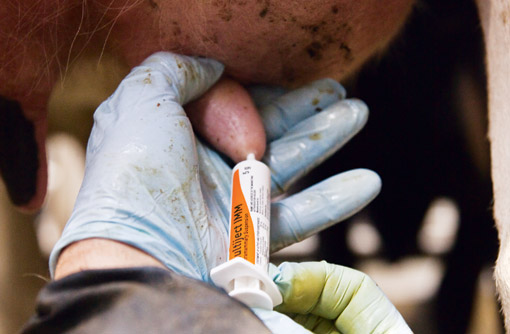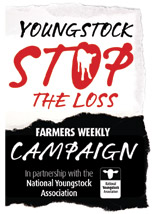Protocols can boost fertility and health

A trip across the pond to learn about dairying has highlighted the importance of protocols for one young farmer looking to improve efficiency, Gemma Mackenzie reports
Following a trip to America working on and visiting several dairy farms, Robert McDonald from Kelloe Mains Farm, Duns, has come back to the family farm with a view of using his new found knowledge to improve efficiency and productivity.
The family currently milk 440 Holstein-Friesians in a high input, high output system. Most forage is home-grown on the 1,012ha (2,500-acre) farm, where the cows average 10,000 litres a year from a three times a day milking.
“I was over in the States for two months and during my time there I visited about 20 farms. I found the Americans were very efficient. We had some protocols in place before, but it’s a lot more defined now,” says Mr McDonald.
Synchronisation/ Fertility
The biggest challenge facing the McDonalds is bringing down the calving age – currently at 28 months – but through a synchronisation programme with strict protocols, they have made big strides to improve this.
“We have moved towards breeding for higher production and better feed efficiency, because I think it’s one of the minimum requirements for milking. As a result we are going to have an influx of heifers so we are going to cull a bit harder; we want to keep the rate at about 30-40%.”
Heat detection is generally by eye, and all fresh cows stay together until they get their first prostaglandin shot at 36-42 days, before being given an activity collar and being introduced into the herd.

Mr McDonald says: “To be honest, I’m tempted to not serve before 73 days, and service everything on a timed AI heat because I have seen enough evidence to say we can get a 50% conception rate that way.”
The farm currently operates a presynch/ovsynch system (see box). Following this strategy, am average pregnancy rate of 29% has been achieved.
Mr McDonald says: “The pregnancy rate is still increasing from when I started the presynch/ovsynch programme, and even better results could be achieved if we were to put in a heat detection system as well.”
Step-by-step guide to the Presynch/ovsynch programme used at Kelloe Mains Farm
Presynch• 36-42 days after calving the cows are given a shot of prostaglandin.
• A second shot of prostaglandin is given at 50-56 days.
• Anything not served by 64-70 days is put on an ovsynch programme.
Ovsynch Programme (as used on the cows)
• Gonadotropin-releasing hormone (GnRH) administered.
• Seven days later, a shot of prostaglandin is given.
• 56 hours later, a further GnRH is given.
• 16 hours later the cows are served.
In addition, as part of the drive to bring down calving age and improve fertility, he has recently completed trials of two different co-sync CIDR programmes on groups of 34 heifers.
The two programmes adopted were:
Programme One
• A CIDR is put in alongside the first GnRH shot
• Seven days later a shot of prostaglandin is given and the CIDR is taken out
• 72 hours later a second GnRH shot is given and the heifers are served
Programme Two
• A CIDR is put in alongside the first GnRH shot
• Five days later a shot of prostaglandin is given and the CIDR is taken out
• Three days later a second GnRH shot is given and the heifers are served
Following these trials, Mr McDonald achieved a conception rate of 60% with programme one, and a conception rate of 42% with programme two.
And on the back of this trial, he now plans to permanently use the seven-day co-sync CIDR programme (Programme One) on the heifers.
Mr McDonald says: “Eventually I want to serve to natural heats with sexed semen. I’d still do a pre-synch. I plan to give them prostaglandin as soon as they come into the pen at about 13 months old.”
When it comes to selecting semen, Mr McDonald puts together a plan of what he wants from the herd over the next 10 years specifying what areas he would like to improve on, and subsequently bulls are selected based on the desired traits.
All cows and heifers have been served using semen from genomic sires since May. “You can get so much more genetic gain from it,” he explains.
“Heat detection has become easier since we moved to three times a day milking, due to more condensed times to show heat. But the best thing about the programme is they will all bull together. Batch serving them is a lot easier, and 60% of our serving is done on one day of the week.”
YoungstockAnother change at Kelloe Mains Farm has been a move to milk testing and blood testing for Johne’s before collecting colostrum for the calves.
Mr McDonald explains: “We milk test for Johne’s to identify what colostrum we can and can’t take, and also back it up with blood tests on anything that has tested positive, just to be double sure.
“The calves are given six litres of colostrum in the first eight hours – three litres at birth and three litres eight hours later – and then put them on to milk replacer which is given three times a day on automated machines.”
The calves are given the option of straw from about five days old, and once they reach 40-45 days old they are introduced to the dairy ration which is fed until they are eight months old.
Milking routineA move to milking three times a day – 3am, 11am and 7pm – has also paid off for the McDonalds with a two-litre daily yield increase to 33.5 litres/day within two months.
“Since we moved to three times a day milking, our somatic cell count has dropped by 35,000 cells/ml, averaging at about 140,000 cells/ml. Before we pre-sprayed and wiped with cloths, which were then washed in the washing machine, but we have now changed to using a foam pre-dip because it halves the chemical costs and ensures better contact on each teat.”
A protocol for mastitis has been put in place, and as a result cows are only tubed by the herdsman or assistant herdsman.
Mr McDonald explains: “None of the mastitis cows are tubed by the milkers. As soon as one is identified, it is flagged up on the computer system, and the cow is put into the separation pen.
“It will then come back round at the end of milking, for the herdsman and assistant herdsman to do all the tubings.”
In addition, a protocol is in place to tackle lameness; the new assistant manager has been trained in foot trimming and the aim is to trim 10% of the herd every week.
More information
Read other top tips on getting heifers in calf at www.fwi.co.uk/heiferfertilityFind out what else we can learn from USA dairy farming, including how to achieve top fertility and managing first lactation heifers at https://www.fwi.co.uk/htp://www.fwi.co.uk/idaho
YOUNGSTOCK: STOP THE LOSS Campaign:
 As part of Farmer Weekly’s Youngstock: Stop the Loss campaign, launched on 4 November, good colostrum management and working to calve down at 24 months, as demonstrated on Mr McDonald’s farm, are two key areas identified where dairy producers can realise the full potential of their youngstock.
As part of Farmer Weekly’s Youngstock: Stop the Loss campaign, launched on 4 November, good colostrum management and working to calve down at 24 months, as demonstrated on Mr McDonald’s farm, are two key areas identified where dairy producers can realise the full potential of their youngstock.
Farmers Weekly’s Youngstock: Stop the Loss campaign, in partnership with the National Youngstock Association, is backed by key industry partners in the livestock sector, and aims to put a stop to the unnecessary youngstock losses occurring on British farms.
According to a DairyCo funded study – Reducing the wastage in the dairy herd – 8% of dairy calves, including dairy beef, are born dead or die within the first 24 hours of being born. And based on the size of the national dairy herd – 1,814,000 cows – and assuming a 90% pregnancy rate, that equates to a staggering 130,608 calves, or one calf every four minutes.
To help reverse this mortality rate, Farmers Weekly is providing farmers with a series of articles offering practical advice on youngstock rearing, farmer case studies, downloadable factsheets and video how-to guides.
Causes of youngstock mortality vary from farm to farm, so to help producers realise the full potential from their youngstock – the future milkers of the herd – Farmers Weekly has broken down calf rearing into six management areas, providing top tips on best practice in each.
Management areas being covered include: colostrum management, management of calf on milk, weaning and nutrition, calf health, housing, and measuring and monitoring.
Get Involved
• To find out more about the campaign visit www.fwi.co.uk/stoptheloss
• Pledge your support for the campaign at www.facebook.com/stoptheloss
• Share your calf rearing stories at www.fwi.co.uk/youngstockstories
